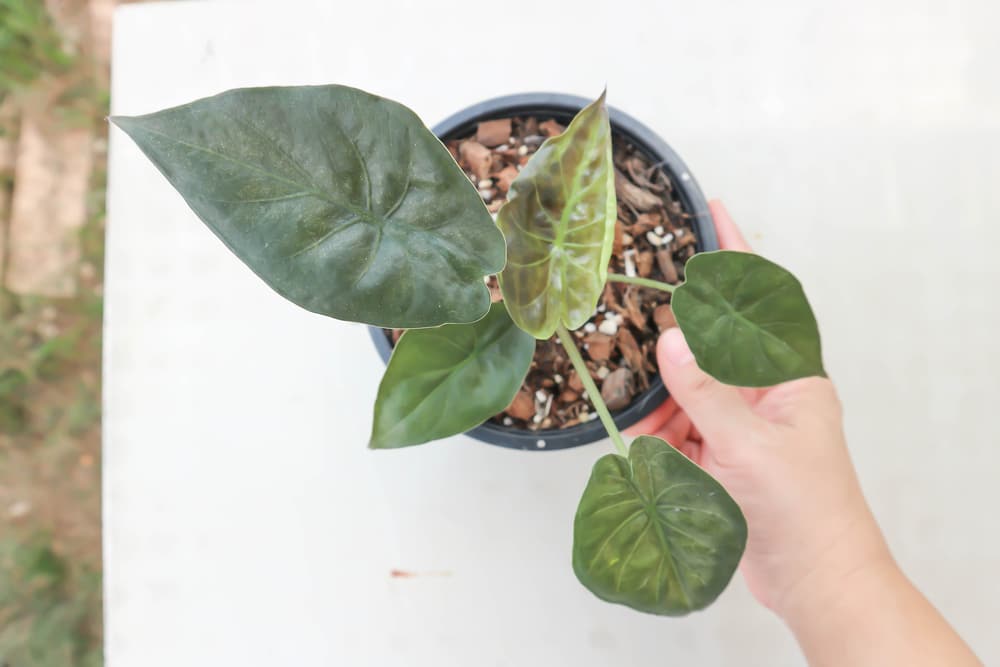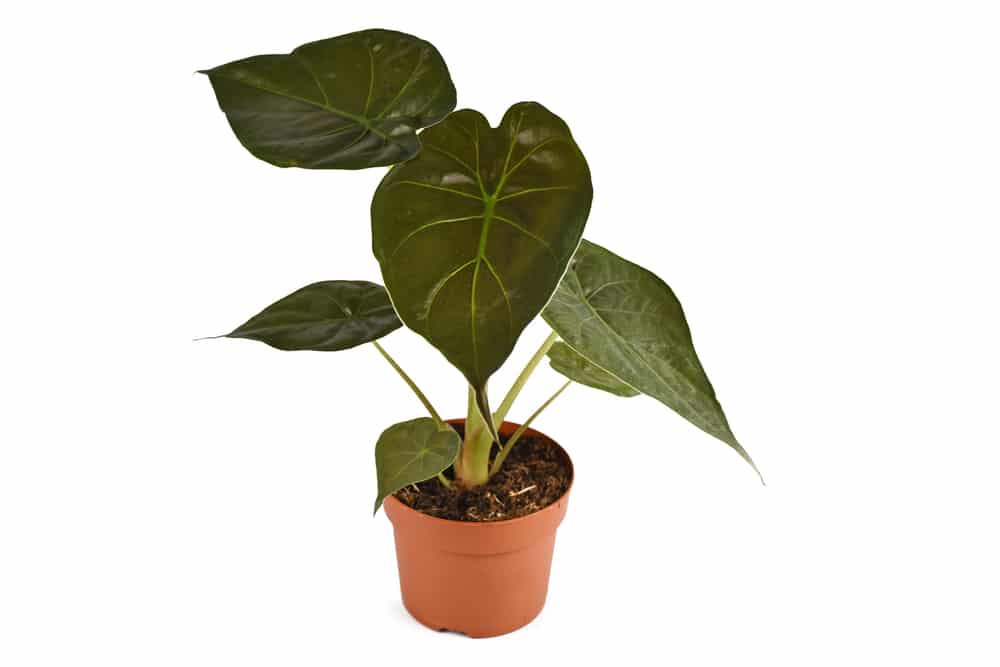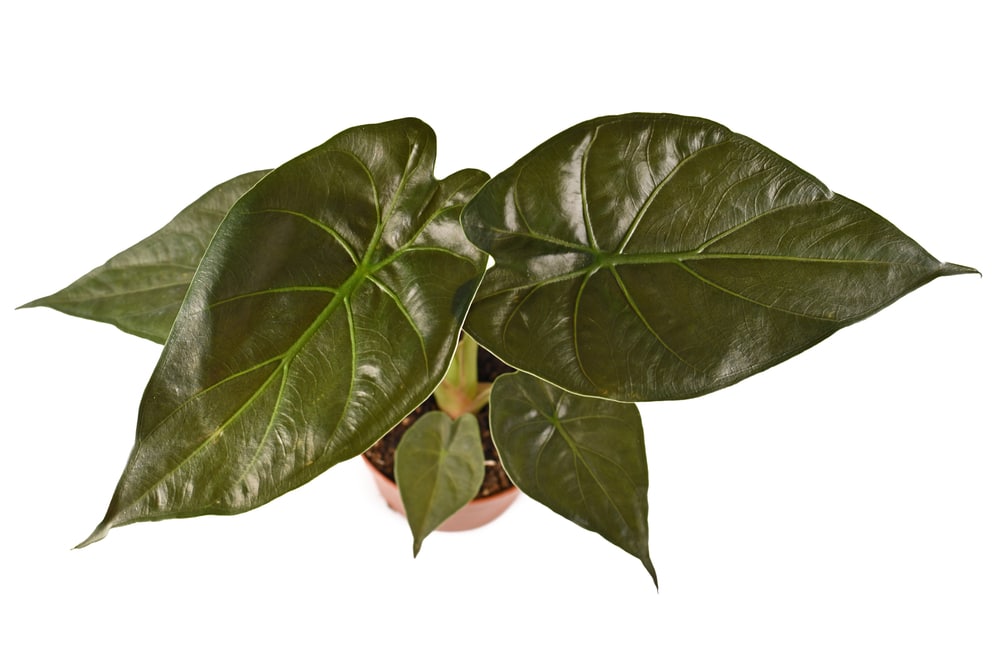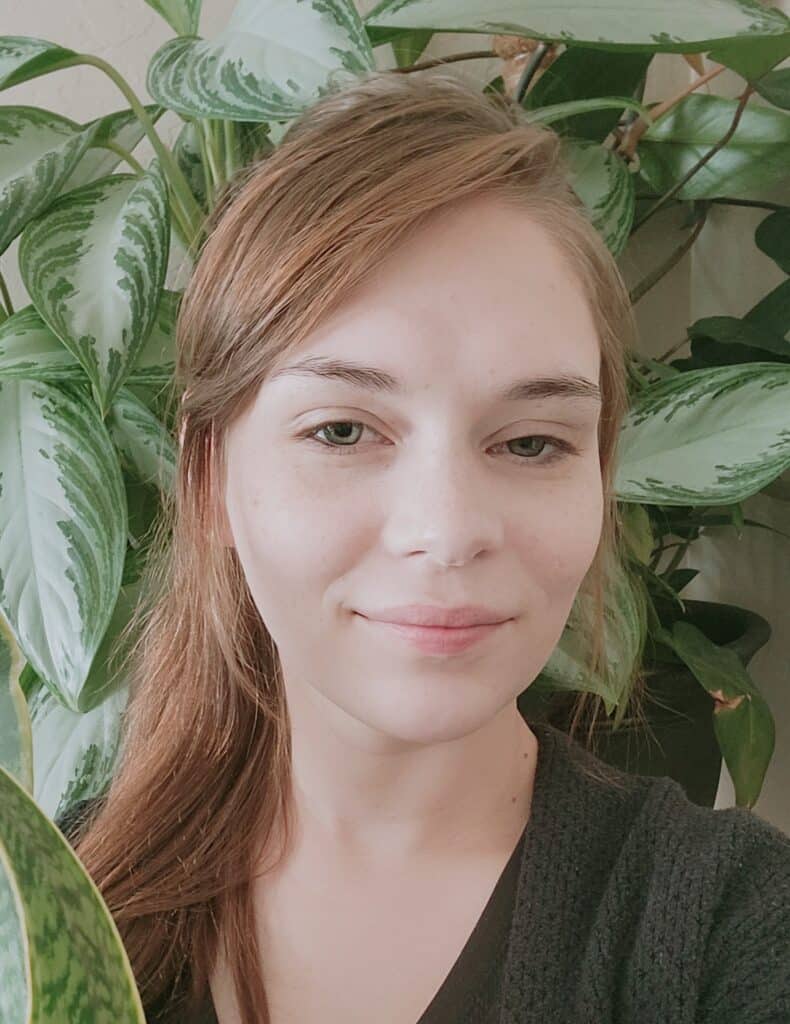The common name of this stunning houseplant says it all. Alocasia wentii features enormous elephant ear-like foliage that is exceptionally hardy and easy to grow. In short, Alocasia wentii is a fabulous houseplant for experienced and beginner houseplant enthusiasts.
Alocasia Wentii Origin and History
This stunning Alocasia variety was first described to science in 1916. It is from the remote tropical mountains of New Guinea. Even though it isn’t a new plant to the science world, indoor horticulturists only recently discovered it.
Alocasia wentii is called hardy because it is a rare Alocasia specimen that will survive in USDA climate zone 7b and above. Very few tropical plants are this hardy.
Hardy Elephant Ear plants capture the attention of indoor plant parents with their 1-foot-long shiny emerald green leaves. The backs of the leaves are metallic-purple, which creates a stunning effect when there is a light breeze. The leaf coloring oscillates between the two beautiful displays as the foliage sways.
The Alocasia wentii grows up to 3-feet tall and wide. It produces 6-8 stems from a central root base, and each stem supports one massive over-sized leaf. The leaf edges are slightly ruffled, adding to the majestic appearance.
Alocasia wentii is also known as Purple Umbrella, New Guinea Shield, and Giant Elephant Ear.

Alocasia Wentii Care Guide
This section covers important Alocasia wentii care topics such as watering, lighting requirements, fertilization, and more.
Growth Habit
Like other Alocasia plants, the Giant Elephant ear turns over new leaves frequently. It doesn’t just grow new ones, though. It only can support 6-10 of the massive leaves at one time. So, anytime it is growing a new leaf, it may also be shedding an old one at the same time. This is a normal process with Alocasias – they shed and grow new leaves regularly.
Hardy Elephant Ear plants enter a period of dormancy every year, usually during winter. During this time, you’ll need to reduce watering and stop fertilizing, so the plant can rest and relax before the next growing season.
During dormancy, Alocasia wentii may drop leaves and look generally sad. It may even drop all its leaves – this is a common occurrence. Don’t worry; your plant is not dead.
Let it be; let it rest, and in the spring, you’ll see new stems sprouting. Alocasia wentii dropping all of its leaves is a natural part of the lifecycle. Some people find this very frustrating, but to keep your plant happy, you need to respect its downtime.
Alocasia plants are known to adapt to change slowly. They don’t tolerate change well, and there almost always will be a period of adjustment when it moves to any new location. It may look sad during this time, but just keep watering appropriately and provide the basic care, and it will bounce back.
Light
Bright, indirect light is ideal for Alocasia wentii. Don’t put the plant right in front of a window where it will get direct sunlight – this will burn the leaves and dry out the soil too quickly.
Instead, place the Alocasia several feet away from the window so it will get light but not any directly on its foliage. Another option is to use blinds or a sheer curtain to block the harshest sun rays.
Alocasia wentii doesn’t do well in the shade. Even partial shade will stunt leaf growth and reduce some of the stunning coloring. Partial shade won’t kill the plant, but it will limit its brilliance.
The Giant Elephant Ear will lean towards a light source. To keep the foliage growth even, give it a quarter-turn every time you water, and Alocasia wentii will grow evenly.
Water
The Giant Elephant Ear likes lightly moist soil that is well-draining and rich with nutrients. These plants don’t like having soggy soil, and they don’t like to dry out completely. They want a nice balanced moist environment.
Overwatering is a common problem with Alocasias. To avoid this, always check the soil beforehand to see if it needs water. Stick your fingers in the top two inches of soil. Hold off watering for a few more days if the soil is still damp. However, if it is dry, water thoroughly.
Be sure to check the soil moisture every time; don’t make assumptions about watering. Indoor climates change with the seasons, which means watering needs also change. Air conditioning, drafts, heating, and other variables impact how often the plant needs water.
Alocasia wentii tends to get super thirsty when it is producing new foliage. When you see your plant sprouting a new leaf, check the soil moisture more often to make sure all is okay.
Temperature and Humidity
The optimal temperature is between 70-80 degrees. However, Alocasia will be okay as long as the temperature isn’t below 55F. If it doesn’t have the ideal temperature, it won’t grow as quickly, and the foliage likely won’t get as large.
Humidity needs for the Hardy Elephant Ear are critical. Tropical plants must have high humidity, or their leaves will develop brown tips and die. Alocasia wentii prefers humidity levels between 60-80%. At the very minimum, it should be above 60%.
To increase humidity in your home, you can buy a small humidifier for your plants. This option provides the best results. Alternatively, you can set up a DIY pebble tray humidifier. These work well but not nearly as well as an actual humidifier.
To make a pebble tray humidifier, fill a small baking sheet with pebbles or small rocks. Place the potted plant on top of the rocks. Finally, fill the tray with water. As the water evaporates, moisture is added to the air. You’ll need to refill the tray often to keep it working well.
Soil and Potting
The best potting soil for Alocasia wentii is an indoor aroid houseplant mix that is well-draining. Standard houseplant soil is okay but is usually a bit too dense. We always add in a couple of extra handfuls of coco coir and perlite to improve water retention and drainage. The key is for the soil to hold precisely what the plant needs and drain all the excess.
Always use a potting container with drainage holes. A container without drainage holes makes the soil retain too much water, which often leads to root rot.
Fertilizer
Add a well-balanced soil once a month during the growing season. Hold off adding fertilizer in the winter when the plant is resting.
Pruning
Pruning isn’t necessary except to remove dead or dying foliage. You can prune the leaves off if they’re too big for the space and slow down their growth. It won’t hurt the plant.
Repotting
Repotting is essential to encourage Alocasia to grow. The Giant Elephant Ear should be repotted every year in spring to replenish the soil (and nutrients) and allow it to grow to its full magnificence.
Repot to a container that is one size up each time. Don’t move it suddenly to a much larger container as this causes overwatering issues, which might lead to root rot. If you don’t want it to grow bigger, repot it to the same container.
Toxicity
All Alocasias are toxic to pets and children. Keep this one up and away from cats, dogs, and small children.

Alocasia Wentii Propagation
Alocasia plants propagate from divisions. The plant grows from a rhizome root which produces corms and offsets. These offsets can be carefully cut off and planted. And, the corms can be gathered and planted. These methods aren’t complicated but are pretty different from the more common cutting propagation that is done with most other houseplants.
- Only do divisions from strong, healthy, and mature plants.
- Do the propagating in spring when the plant is strongest. The best time is when you are repotting, so the plant roots only get disturbed one time.
- Carefully lift the plant out of the container and shake off any excess soil.
- Look for the offsets, which are small short, lateral shoots. They’ll be connected to the parent plant and often get tangled up. You may also find corms, which are the bulbs before they sprout into offsets.
- You can divide the roots to take the offsets or remove the corm bulbs.
- Sometimes there are so many bulbs they fall right from the roots with a firm shake.
- Carefully untangle the roots, being careful not to tear them. You may need to use a pair of sterilized scissors to cut them apart.
- Plant the little offshoots or corms in damp soil and place them in indirect light in a warm location.
- Keep the soil lightly moist while offshoots get established. It may take a few months, so patience is vital.
Alocasia Wentii Pests and Disease
This section cover common pests and diseases that you should look out for when keeping Alocasia wentii.
Root Rot
Alocasia wentii roots are soft and susceptible to overwatering. When the roots get too soggy, they develop root rot. To prevent this, always make sure that the top two inches of soil are dry before watering. Root rot usually spells death for the plant, so it is essential to take special care with watering and do it properly.
Spider Mites, Aphids, and Mealy Bugs
These tiny pests can occur with any houseplants. They quickly become massive infestations when not treated right away, so it is essential to be vigilant. Usually, you’ll see little black spots on the foliage where the insects have sucked out the plant’s juices. Or, you’ll notice stunted or weird growth.
The best way to combat all of these pests is a regular application of neem oil solution. Mix two teaspoons of neem oil with one teaspoon of dish soap in a quart-size spray bottle, then fill the rest with water. Shake it well and spray the entire plant, being careful to get the leaf undersides, stems, and soil. Repeat this spraying every 5-8 days, as needed.

Frequently Asked Questions
Here are a few of the most frequently asked questions about Alocasia wentii care:
Will my Alocasia wentii flower?
Yes, it may flower if the conditions are right. However, many tropical plants don’t flower indoors because the climate isn’t adequate. Even if Alocasia wentii does flower, it’s not very impressive – very pale spathes that just last a few days.
Why is my Alocasia wentii foliage drooping?
The drooping is caused by insufficient water. The Alocasia is announcing it is thirsty. If you see this, check the soil and water immediately. This is not a good thing to let happen, so don’t use this as a common indication that the plant needs water. Underwatering is stressful for Alocasias.
My Alocasia wentii lost all its leaves; what is happening?
This could be the normal dormancy cycle that happens every year. See the section on growth habits for more about this natural cycle.
Another reason for your Alocasia losing its foliage may be that it is stressed out. This can happen anytime your plant experiences an abrupt change, like being brought inside from outdoors, coming home from the plant store, and sudden changes in lighting or temperature.
Thankfully, an Alocasia wentii doesn’t die when it loses all it leaves. It is just hibernating for a bit to recover. If it’s during the regular growing season, place your plant in a nice warm location with lots of indirect light, and it should bounce back. If it is winter, let the plant be, and it will recover in the spring when the climate is better.
The leaves on my Alocasia wentii are yellow; what’s going on?
Overwatering is the main cause of yellow leaves. The plant can’t absorb all the moisture, and the foliage starts to suffer. Check the soil moisture and water thoroughly, as needed.
Why are the leaves on my Alocasia wentii brown?
Brown leaves usually indicate low humidity. If the leaf tips are brown, that is certainly a sign that there isn’t enough humidity. Increase the humidity to prevent this from happening.
Brown spots on the leaves happen when the plant is getting too much direct sun and is getting sunburned. Move the plant to a location with less direct sunlight.
This Alocasia is a vibrant, stand-out houseplant with enormous elephant ear foliage that is impossible to ignore. Place Alocasia wentii in a location where it can show off its leaves and where you can be sure to enjoy this fantastic houseplant.

